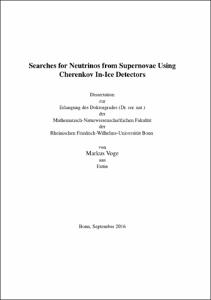Voge, Markus: Searches for Neutrinos from Supernovae Using Cherenkov In-Ice Detectors. - Bonn, 2017. - Dissertation, Rheinische Friedrich-Wilhelms-Universität Bonn.
Online-Ausgabe in bonndoc: https://nbn-resolving.org/urn:nbn:de:hbz:5n-46547
Online-Ausgabe in bonndoc: https://nbn-resolving.org/urn:nbn:de:hbz:5n-46547
@phdthesis{handle:20.500.11811/7138,
urn: https://nbn-resolving.org/urn:nbn:de:hbz:5n-46547,
author = {{Markus Voge}},
title = {Searches for Neutrinos from Supernovae Using Cherenkov In-Ice Detectors},
school = {Rheinische Friedrich-Wilhelms-Universität Bonn},
year = 2017,
month = may,
note = {Supernovae mark the violent death of massive stars. They are among the most energetic processes known to exist in the Universe. Neutrinos play crucial roles in supernova processes. Besides the low-energy neutrinos emitted during the core-collapse process of the supernova, there may be neutrinos of much higher energies that are generated after the core-collapse.
In this work, a new detector embedded in Antarctic glacier ice is studied, with sensitivity to extra-galactic supernova low-energy neutrino bursts. It is demonstrated that the development of optical sensors with large effective area and low noise rate is a requirement. For the proposed detector, several extra-galactic supernova neutrino detections per year are feasible.
In addition, a multi-messenger data analysis program is carried out, which registers high-energy neutrino bursts with the IceCube detector and triggers follow-up observations with optical telescopes. No significant excess of neutrino bursts is found. Therefore, upper limits on the jet supernova model are derived. For model values of the jet Lorentz factor Γjet = 10 and the jet kinetic energy Ejet = 3 × 1051 erg, only about 8% of all core-collapse supernovae
hosting a jet are consistent with the data.},
url = {https://hdl.handle.net/20.500.11811/7138}
}
urn: https://nbn-resolving.org/urn:nbn:de:hbz:5n-46547,
author = {{Markus Voge}},
title = {Searches for Neutrinos from Supernovae Using Cherenkov In-Ice Detectors},
school = {Rheinische Friedrich-Wilhelms-Universität Bonn},
year = 2017,
month = may,
note = {Supernovae mark the violent death of massive stars. They are among the most energetic processes known to exist in the Universe. Neutrinos play crucial roles in supernova processes. Besides the low-energy neutrinos emitted during the core-collapse process of the supernova, there may be neutrinos of much higher energies that are generated after the core-collapse.
In this work, a new detector embedded in Antarctic glacier ice is studied, with sensitivity to extra-galactic supernova low-energy neutrino bursts. It is demonstrated that the development of optical sensors with large effective area and low noise rate is a requirement. For the proposed detector, several extra-galactic supernova neutrino detections per year are feasible.
In addition, a multi-messenger data analysis program is carried out, which registers high-energy neutrino bursts with the IceCube detector and triggers follow-up observations with optical telescopes. No significant excess of neutrino bursts is found. Therefore, upper limits on the jet supernova model are derived. For model values of the jet Lorentz factor Γjet = 10 and the jet kinetic energy Ejet = 3 × 1051 erg, only about 8% of all core-collapse supernovae
hosting a jet are consistent with the data.},
url = {https://hdl.handle.net/20.500.11811/7138}
}






